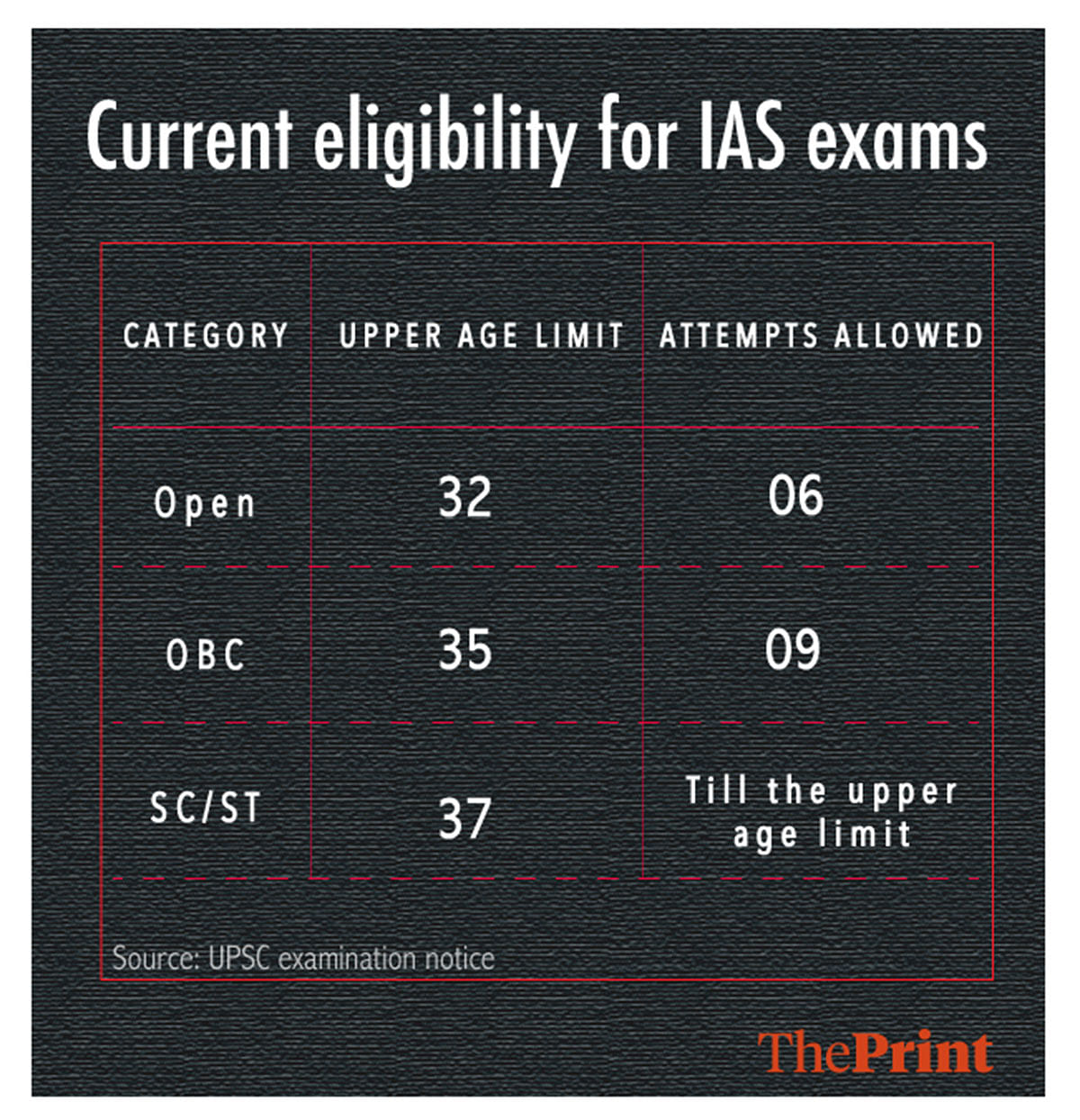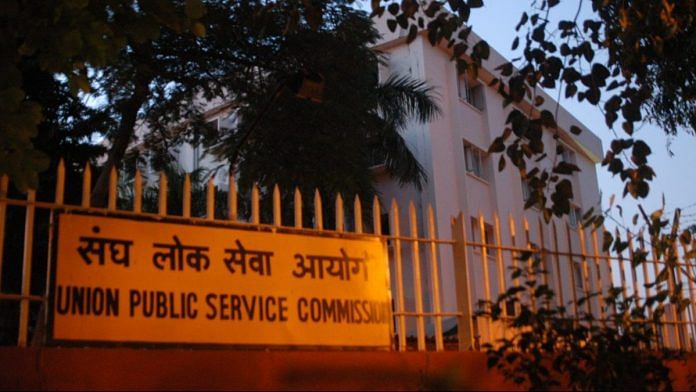The service tenure of all officers should be the same.
The Niti Aayog has suggested a new age bar of 27 years for entry into the central civil services for the general category candidates. The Niti Aayog paper was silent on the age limit for SC, ST and OBC candidates, who constitute almost half (49.5 per cent) of the selected candidates for the civil services. Although the union government has clarified that status quo will continue, the idea has triggered a nationwide debate.
If administrative efficacy is the criterion, then the natural corollary is to reduce the age limit for all categories by five years.
According to the present rules, this is the eligibility for the civil services examination:

There are also some special relaxations for the physically challenged, J&K domiciles and servicemen disabled during duty.
Why is the status quoist UPSC giving special privileges in the age limit to reserved category candidates? What explains this benevolence when it has played no role in ensuring diversity or social justice?
Reservation in the civil services emanates from Article 16(4) of the Constitution – “Nothing in this article shall prevent the State from making any provision for the reservation of appointments or posts in favour of any backward class of citizens which, in the opinion of the State, is not adequately represented in the services under the State.”
But it does not say anything about age limit or number of attempts allowed for taking any exam for the civil services or other government jobs. The UPSC notification for the civil services exam fails to offer a reason. It simply lists the relaxations. Even UPSC and DoPT websites are not helpful.
Also read: Niti Aayog pushes Modi govt’s ‘domain experts’ idea for civil services
This may be a government dole to the deprived sections of the society so that a large number of candidates from such categories can appear for these exams. The second explanation is that there will not be enough candidates in the reserved categories if the age relaxation is not given. The third explanation is that since most SC, ST and OBC students belong to rural areas, they start schooling late.
The government report on higher education says that there are 799 universities, 39,071 colleges and 11,923 standalone institutions in India. They churn out 39.78 lakh graduates every year. If we check the enrolment rates, SC students constitute 13.9 per cent and ST students 4.9 per cent of the total enrolment. About 33.75 per cent of the total students enrolled belong to the OBC category. This data is only for a year and the numbers are increasing.
As the minimum educational qualification for the civil services exam is graduation, we can assume that there is a large talent pool from each social category. Every year, more than 10 lakh candidates appear for the civil services exam. The number of candidates who are finally selected remains less than 1000, and that number too is decreasing. This year, there are only 782 vacancies. Out of the total vacancies in the civil services, 49.5 per cent are reserved for the SC, ST and OBC candidates.
This demolishes the argument that age relaxation for the reserved candidates is meant to ensure that a large number of them take this exam. The talent pool in the reserved categories will be sufficiently large even if there is no age relaxation.
Also read: Suicide prompts three IAS officers to show the unglamorous side of civil services
Can this ‘facility’ of age relaxation cause any harm to the reserved category?
Yes. It is causing some serious anomaly in the bureaucracy, especially at the top level. As the retirement age for all the officers is the same at 60 years, candidates availing of the age relaxation will serve a shorter tenure. The service gap can be huge – theoretically, there can be a gap of 16 years as someone from the general category will be entering the service at the age of 21 while another candidate from the reserved category is joining the service at 37. The chances of a young officer reaching the top will always be higher. And the top level of the bureaucracy is where policy decisions are made.
Look at some of the evidences of this anomaly in the top layer of bureaucracy.
- The union government said in the Rajya Sabha that of the 85 secretaries, only four are from the SC/ST category. At the entry level, 22.5 per cent of the total officers are recruited from the SC/ST category, and accordingly there should be at least 17 SC/ST officers at the secretary level.
- In 2012, the situation was worse. The government accepted that there was not a single officer from the SC category at the secretary level. At the level of additional secretary, there were four SC/ST officers from a total of 108 officers.
- In 2015, the minister of state in DoPT informed the Rajya Sabha that there was no OBC officer at the secretary level. Of the 278 joint secretaries, 34 were from SC/ST and 10 from OBC category.
- The union government last year said that there were only four SC/ST secretaries from a total of 66. At the level of joint secretary, of the 174 officers, only 26 were from the SC/ST category. The government also said that after the entry level of group A, there is no provision of reservation.
This data shows that there is something wrong with the appointment and service rules for the bureaucracy that ensures that the upper layer, which actually runs the country, is not diversified and doesn’t have adequate representation from all social groups. This is contrary to the Article 16(4) of the Constitution.
There are two more issues related to the age relaxation clause. There is a possibility that officers who enter the services availing of the age relaxation can have low self-esteem and may face a problem in getting due respect in their peer group.
The second issue is that at the age of 37, it will be difficult for someone to recalibrate life. That is a precious waste of human resources.
Also read: Older IAS entrants tend to have lower performance levels, says a global study
What can be done?
– Nothing should be done at one go or abruptly. The interest of the candidates who are following the old system of age relaxation should be taken care of. Change should be implemented in a phased manner.
– After five years, there should be no age or attempt relaxations for SC, ST and OBC candidates.
– If this is not possible, then there should be a differential age of retirement for different officers based on the age of their entry into the service. Service tenure of all officers should be same.
The author is a senior journalist.




You are the worst media personnel I have heard on tv who always peddles this extending reservation or promotion with consequential seniority bullshit all the ,what about sons and daughters of bureaucrat who appear in this exam and exams of medical Colleges and other prestigious institutes ,are they from a poor back ground with their parents in elite services and they having all the facilities and are born born with silver spoon ,you and people like are the one who want to destroy the merit of this country by playing this victim card all the time for 70 years
Can’t believe that this serial instigator of caste hatred is a “senior journalist”. This person is a classic example of how neo-nazis have infiltrated the media and pushing their dangerous agendas similar to the one peddled by caste extremist groups of TN. This article, like the one against brahmins some days ago, is full of omissions and assumptions devoid of logic and truth. Simple question – can all bureaucrats be guaranteed equal length of employment irrespective of their date of joining? Are all SC/ST so bad that they can join only on reaching 37? Are all UR class people so smart that they will get in at 21? Do all SC/ST/OBC live in rural areas as is alleged? What about TN, where 95% of population is categorised as “backward”. Do they all live in rural areas? Are SCs in Delhi living in rural areas? Lies, falsehood & bogus statistics demolished in a minute. This man is called a “Senior Journalist”!!!
Many things one does not agree with in this maze, but a differential age of retirement is truly catastrophic. These are the elite services, the quality of senior civil servants has a profound bearing on governance within the country and India’s place in the world. Enough systemic harm has been done by extending the scope of affirmative action beyond where it was meant to be. In an age where so many ministers are innocent of governance qualities, let the Secretaries run the show competently.